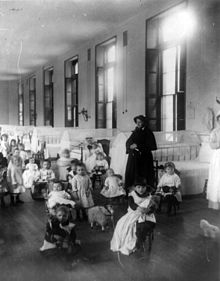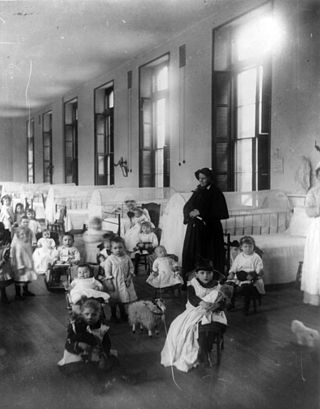
Adoption is a process whereby a person assumes the parenting of another, usually a child, from that person's biological or legal parent or parents. Legal adoptions permanently transfer all rights and responsibilities, along with filiation, from the biological parents to the adoptive parents.
Child abandonment is the practice of relinquishing interests and claims over one's offspring in an illegal way, with the intent of never resuming or reasserting guardianship. The phrase is typically used to describe the physical abandonment of a child. Still, it can also include severe cases of neglect and emotional abandonment, such as when parents fail to provide financial and emotional support for children over an extended period. An abandoned child is referred to as a foundling. Baby dumping refers to parents leaving a child younger than 12 months in a public or private place with the intent of terminating their care for the child. It is also known as rehoming when adoptive parents use illegal means, such as the internet, to find new homes for their children. In the case where child abandonment is anonymous within the first 12 months, it may be referred to as secret child abandonment.

The Thomas Coram Foundation for Children is a large children's charity in London operating under the name Coram. It was founded by eighteenth century philanthropist Captain Thomas Coram who campaigned to establish a charity that would care for the high numbers of abandoned babies in London, setting up the Foundling Hospital in 1739 at Lamb's Conduit Fields in Bloomsbury. By the 1950s social change had led to the closure of the hospital and the charity adopted the broader name Thomas Coram Foundation for Children in 1954.

The Foundling Hospital was a children's home in London, England, founded in 1739 by the philanthropic sea captain Thomas Coram. It was established for the "education and maintenance of exposed and deserted young children." The word "hospital" was used in a more general sense than it is in the 21st century, simply indicating the institution's "hospitality" to those less fortunate. Nevertheless, one of the top priorities of the committee at the Foundling Hospital was children's health, as they combated smallpox, fevers, consumption, dysentery and even infections from everyday activities like teething that drove up mortality rates and risked epidemics. With their energies focused on maintaining a disinfected environment, providing simple clothing and fare, the committee paid less attention to and spent less on developing children's education. As a result, financial problems would hound the institution for years to come, despite the growing "fashionableness" of charities like the hospital.

An orphanage is a residential institution, total institution or group home, devoted to the care of orphans and children who, for various reasons, cannot be cared for by their biological families. The parents may be deceased, absent, or abusive. There may be substance abuse or mental illness in the biological home, or the parent may simply be unwilling to care for the child. The legal responsibility for the support of abandoned children differs from country to country, and within countries. Government-run orphanages have been phased out in most developed countries during the latter half of the 20th century but continue to operate in many other regions internationally. It is now generally accepted that orphanages are detrimental to the emotional wellbeing of children, and government support goes instead towards supporting the family unit.
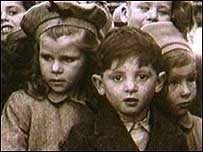
Foster care is a system in which a minor has been placed into a ward, group home, or private home of a state-certified caregiver, referred to as a "foster parent", or with a family member approved by the state. The placement of a "foster child" is normally arranged through the government or a social service agency. The institution, group home, or foster parent is compensated for expenses unless with a family member.

Charles Loring Brace was an American philanthropist who contributed to the field of social reform. He is considered a father of the modern foster care movement and was most renowned for starting the Orphan Train movement of the mid-19th century, and for founding Children's Aid Society.
A foundling hospital was originally an institution for the reception of foundlings, i.e., children who had been abandoned or exposed, and left for the public to find and save. A foundling hospital was not necessarily a medical hospital, but more commonly a children's home, offering shelter and education to foundlings.
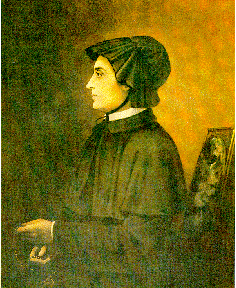
The Sisters of Charity of Saint Vincent de Paul of New York, most often known as the Sisters of Charity of New York, is a religious congregation of sisters in the Catholic Church whose primary missions are education and nursing and who are dedicated in particular to the service of the poor. The motherhouse is located at Mt. St. Vincent in the Riverdale section of the Bronx. They were founded by Elizabeth Ann Seton in 1809.
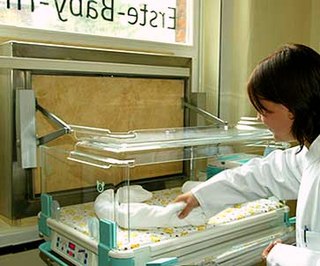
A baby hatch or baby box is a place where people can leave babies, usually newborn, anonymously in a safe place to be found and cared for. This was common from the Middle Ages to the 18th and 19th centuries, when the device was known as a foundling wheel. Foundling wheels were abandoned in the late 19th century, but a modern form, the baby hatch, was reintroduced from 1952 and since 2000 has been adopted in many countries, most notably in Pakistan where there are more than 300. They can also be found in Germany (100), the United States (150), Czech Republic (88) and Poland (67).

Children's Aid, formerly the Children's Aid Society, is a private child welfare nonprofit in New York City founded in 1853 by Charles Loring Brace. With an annual budget of over $100 million, 45 citywide sites, and over 1,200 full-time employees, Children's Aid is one of America's oldest and largest children's nonprofits.

The Orphan Train Movement was a supervised welfare program that transported children from crowded Eastern cities of the United States to foster homes located largely in rural areas of the Midwest. The orphan trains operated between 1854 and 1929, relocating from about 200,000 children. The co-founders of the Orphan Train movement claimed that these children were orphaned, abandoned, abused, or homeless, but this was not always true. They were mostly the children of new immigrants and the children of the poor and destitute families living in these cities. Criticisms of the program include ineffective screening of caretakers, insufficient follow-ups on placements, and that many children were used as strictly slave farm labor.

Sister Irene was an American nun who founded the New York Foundling Hospital in 1869, at a time when abandoned infants were routinely sent to almshouses with the sick and insane. The first refuge was in a brownstone on E.12th St. in Manhattan, where babies could be left anonymously in a receiving crib with no questions asked. The practice was an echo of the medieval foundling wheel and an early example of modern "safe haven" practices.
The Children's Home of Pittsburgh, established in 1893, is an independent non-profit organization in Pittsburgh, Pennsylvania. The organization's mission is "to promote the health and well-being of infants and children through services which establish and strengthen the family," including adoption, day care and pediatric health care.

St. Ann's Center for Children, Youth and Families, formerly known as St. Ann's Infant and Maternity Home, is administered by the Daughters of Charity of Saint Vincent de Paul within the Roman Catholic Archdiocese of Washington. It is located at 4901 Eastern Avenue in Avondale, Maryland. It provides housing and support to pregnant and parenting young women and their children, as well as quality day care to the children of working families.

Hetty Feather is a book by English author Jacqueline Wilson. It is about a young red-haired girl who was left by her mother at the Foundling Hospital as a baby and follows her story as she lives in a foster home before returning to the Foundling Hospital as a curious and bad-tempered five-year-old. There are more books to the "series" of Hetty Feather, which are recommended for ages 9–11 according to the author. CBBC created a TV series based on the book, with Isabel Clifton portraying Hetty. The programme was first aired in 2015. In the United States BYUtv has the US broadcast rights and began airing it in March 2018.
The Dominican Sisters of Blauvelt are a religious congregation within the Dominican Order of religious sisters founded in 1890. They are based in the town of Blauvelt, New York, a northern suburb of New York City. Their traditional service has been childcare, both through teaching and caring for orphans.

The Angel Guardian Home, formerly the Angel Guardian Home for Little Children is a Catholic orphanage in the Dyker Heights area of Brooklyn, New York.
Catholic Guardian Services (CGS) is a human services non-profit organization sponsored by the Catholic Charities of the Archdiocese of New York with programs to help members of the disadvantaged population in the New York metropolitan area.
Orchard Place is an agency based in Des Moines, Iowa, United States, which provides inpatient and outpatient mental and behavioral health services for youth. It is one of the oldest social service agencies in Des Moines which began as the Home for Friendless Children, an agency dedicated to finding foster or adopted homes for destitute or abandoned children. Today, Orchard Place is headquartered in the South Side of Des Moines and provides services at the Orchard Place Campus, the Child Guidance Center and the PACE center.




